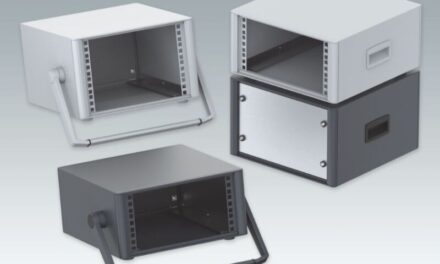 Craig Forrester at Stäubli (UK) explores advancing techniques for liquid cooling in enclosures, for the new wave of modern electronic devices
Craig Forrester at Stäubli (UK) explores advancing techniques for liquid cooling in enclosures, for the new wave of modern electronic devices
The heat being generated by high power electronics is outstripping the cooling capability of air, promoting a move towards more powerful techniques. Leading in this development is the use of liquids to transfer heat directly from electronic components inside enclosures to external heat exchangers.
Faster processing speeds, increased capacity and higher power density in electronics produce more heat, higher junction temperatures and increased risk of failure. Traditionally, air-cooling has been the solution, using a combination of heat sinks, heat pipes and fans to remove the heat produced from the enclosure. High power electronics now being used in many real time processing applications are rapidly outstripping the capability of any air based cooling system.
Liquids have a much higher cooling capability than air; water is 24 times more conductive than air and can be up to approximately 100 times more efficient at removing heat. Liquids are therefore ideal for use in transferring the heat being generated away from the electronic components and enclosure and into a heat exchanger where the liquid can be efficiently cooled and recycled back into the enclosure cooling system.
Placing liquids in close proximity to sensitive electronics is a major concern. Any spillage in the enclosure would be disastrous – how could spills be avoided?
There are connectors available that have been specifically designed to meet these demanding requirements such as those from Stäubli (UK). Such devices, with a specialised coupling design provide effective circuit connection and disconnection. Flat faced, clean break connector technology guarantees no spillage and eliminates any risk of air or contaminants entering the circuits on connection or disconnection.
Connectors can also be designed for blind connection that can compensate for a large degree of mis-alignment, this ensures that connection to the liquid cooling circuit does not compromise the integrity of the electrical connectors; removal and replacement of liquid cooled enclosures can be as easy as on a traditional air cooled system.
Liquid cooled electronics are now being used across a broad range of applications from radar arrays and imaging systems in the defence sector to power converters in wind turbines. Many Data Centres are evaluating this new technology and the benefits it offers in terms of reduced power consumption, increased processing capacity or reduced footprint.
A recent application illustrates the benefits of liquid cooling. Thermacore Europe, based in Ashington, Northumberland are specialists in thermal management technology, especially for cooling electronics. When designing their latest system using liquid coolant, rather than air, they entrusted Stäubli (UK) to provide the automatic connectors required. Their new system can remove up to 500W of heat energy from a processor with a footprint of 20mm by 30mm and can be readily adapted to fit different server designs, enclosures and component layouts.
The company see liquid cooling as the next important step in data centre servers; 50 percent of the energy currently used in these installations is for cooling, so more effective and efficient liquid cooling offers the ability to significantly increase the computing capacity in the same available space.
Another current example of how these new cooling techniques are now being adopted comes from the defence sector where liquid cooled ATR enclosures are being widely used in real time computing installations supporting pilot vision systems and advanced radar technology. These applications have a high processing power requirement and consequently produce considerable heat.
Boston Design Consultants based in Northampton, in partnership with the IPECO Group, have developed innovative cold wall technology specifically for ATR applications in the defence sector. The cooling capacity on a half ATR short enclosure increases by a factor of 4 to 1200W using their design of cold wall compared to just 350W using a typical air cooled system.
Companies such as this have made the move to liquid cooling far easier to implement than many expected. As a result selecting a product specialist who are able to provide advice on the precise connector solution and configuration to meet the application is possible without raising your temperature.
Stäubli (UK)


